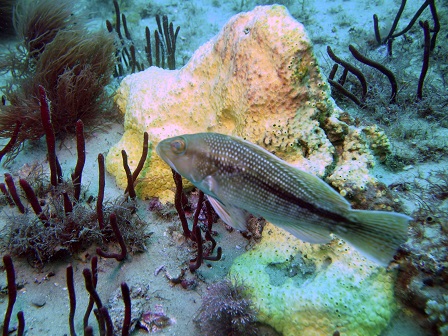SEA SCIENCE: Getting to Know North Carolina’s Natural Reefs

Recent studies on reef fish communities off North Carolina and along the southeastern United States could help determine final boundaries and improve management plans for eight proposed deepwater Marine Protected Areas (MPAs) and four deep-sea coral Habitat Areas of Particular Concern (HAPCs).
Steve Ross and Andrea Quattrini, of the University of North Carolina Wilmington, and other researchers collected baseline information about hardbottom and deep coral bank ecosystems during six years of expeditions funded by the National Oceanic and Atmospheric Administration (NOAA) Office of Ocean Exploration and other agencies, including the N.C. Fishery Resource Grant Program.
MPAs are areas of the marine environment — ocean, coastal and inter-tidal zones, estuaries, or parts of the Great Lakes — where natural and cultural resources enjoy greater protection than surrounding waters. Commercial and recreational uses, management plans and government agencies involved vary. HAPCs are threatened water column and seafloor habitats identified as essential to the health and long-term survival of fisheries. These include spawning, nursery and critical feeding sites.
UNIQUE DEEPWATER COMMUNITIES
North Carolina’s two reef systems — the Outer Shelf Reefs and Lophelia Coral Banks — were not well sampled until a few years ago. Depth, dangerous bottom currents, rugged bottom terrain and the expense of ship time and technology impeded research.
But Ross and Quattrini observed fish composition and behavior and reef structure directly with a video camera mounted to the Johnson-Sea-Link (JSL) submersible and collected bottom data and specimens by trawling and using a hook and line. They also sampled the entire water column — surface, midwater, sargassum, and open ocean — with various nets.
“Exploring below scuba depth is not something we get to do very often,” Ross says. “We found new, undescribed crabs, fishes, and fern-shaped hydroids. Many of the creatures we thought rare in deeper systems are not. We just couldn’t get at them.” Hydroids are animals in the Phylum Cnidoria, along with jellyfish, sea anemones and corals.
The team discovered that North Carolina’s offshore reefs are more extensive and ecologically diverse than previously known. They identified new depths and ranges for many species, including a flat, ray-finned anglefin whiff from eastern Florida and the Caribbean.
North Carolina’s Outer Shelf Reefs, as their name suggests, are located at the edge of the continental shelf, some 75 miles offshore. Recreational and commercial fishers are familiar with these reefs because they offer important fish habitat at accessible depths of 160 to 656 feet. “Hardbottom reefs” are covered with sponges, white hard, soft, and black corals, bivalves, and hydroid colonies.
The researchers found large numbers of sea bass, butterfly fish, gobies, vermilion snappers, grunts, yellowedge and snowy groupers, and jacks. Species diversity proved greatest at the deeper, shelf-edge locations where the bottom temperature remains warm all year because of the nearby Gulf Stream.
The submersible dove more than 2,000 feet in some places to investigate three sites in the Lophelia Coral Banks off Cape Lookout and Cape Fear. Mounds and ridges of coral fused with trapped sediment rise 200 to 300 feet above the sea floor. Broken or dead coral cascade down 60-degree slopes, creating a rubble field.
“We’re still not completely certain that these smaller coral mounds function in the same way as sea mounts,” Ross says. “We might be observing distinct deep reef communities, similar to shallow, tropical reefs, but its too soon to say.”
Lophelia pertusa corals grow very slowly in deep water at temperatures continuously colder than about 50 degrees Fahrenheit. Undisturbed for thousands of years, they can achieve massive sizes and spread great distances without light or photosynthetic algal tenants. Related to jellyfish and anemones, corals can catch microscopic prey using stinging cells in their tentacles. Corals also possess a mucus coating and can absorb nutrients directly through an outer skin.
The technical language and Latin names for fish that appear in the researchers’ academic articles do not do justice to exciting video from the submersible camera Researchers saw three Xiphias gladius during dives at the Cape Lookout coral banks site and three Mobula hypostoma circling above the crests of the Lophelia mounds. (That’s swordfish and devil rays.) At one point, a swordfish attacked the submersible, striking the hull just above Ross’s head.
Sixty-six fish groups, or taxa, were identified. Codlings, roughtip grenadiers, sawbellies and scorpionfish moved through caverns and crevices in greatest number. Cruising the bottom? Lanternfish, Atlantic pearlsides and slope hatchetfish.
CORAL ADVANTAGES
Unlike fringing reefs that protect us from damaging hurricane storm surges, offshore reefs’ limestone frameworks instead divert powerful bottom currents, offering invertebrates places to settle and fish sheltered hideouts. Deepwater reef structures also generate vortices that concentrate nutrient and food resources.
“Beyond these ‘trophic’ or food chain advantages, deep coral reefs may provide important spawning areas and yield biomedical breakthroughs,” Ross says, noting that some types of sponges are used in cancer research.
Long-lived black and bamboo corals in the deep ocean might provide important information about past climate patterns and how coral ecosystems respond to changes in temperature and currents. Like trees, corals grow annual concentric rings that can be counted and aged, back 2,000 years in some cases.
Carbon 14 and trace metal concentrations within the coral tell scientists much about the surrounding water mass, interactions between the ocean and the atmosphere, including carbon mixing, global heating and cooling events, past upwelling strength and plankton dynamics, and the location of the Gulf Stream. Scientists expect data from coral ‘climate proxies’ to improve climate modeling and predictions about the effects of global wanning.
The researchers observed a great deal of plastic and other manmade debris among the reefs, but plastic is only one of many threats to reef ecosystems. Overfishing of snappers and groupers is a problem on the Outer Shelf Reefs, according to the South Atlantic Fishery Management Council (SAFMC). Neither species recover quickly.
If the moratorium on oil exploration off North Carolina’s coast is lifted, then placement of pipelines and cables could damage important habitat, according to Ross. “The U.S. Navy’s proposed sonar system off Camp LeJeune also involves laying cables,” he adds.
For now, deep-water coral ecosystems are only indirectly threatened by global climate changes and wanning sea surface temperatures. Water at great depths remains relatively cool and stable. Deep corals do not host symbiotic photosynthetic algae, thus are immune from coral bleaching events.
Ocean acidification, however, caused by increasing carbon dioxide levels in the atmosphere, potentially affects any sea animal that makes a calcium carbonate shell, Ross explains. Shifts in the direction and speed of the Gulf Stream because of climate changes also might threaten deep reefs.
SCIENCE AIDS MANAGEMENT
Quattrini and Ross believe their baseline studies will help the SAFMC and NOAA draw final boundaries for eight proposed marine protected areas from North Carolina to the Florida Keys. In June 2007, the SAFMC unanimously proposed this network of MPAs to the Secretary of Commerce as Amendment 14 to the Snapper Grouper Fishery Management Plan.
The proposed MPA off North Carolina is the “Snowy Wreck,” named after the many snowy groupers around a steel-hulled wreck. The ‘Type 2’ MPA — a roughly 50-square-mile area southeast of Southport, off Frying Pan Shoals — would prohibit harvest or possession of any species in the snapper grouper management complex.
“The SAFMC currently is proposing the designation of four additional areas of deepwater coral habitat, such as Lophelia beds, as HAPCs and adding measures to protect these areas from fishing-related impacts,” says Mac Currin, chairman of SAFMC’s Snapper Grouper Committee.
“Ross and Quattrini’s work expands our knowledge base and will be critical in identifying the extent and complexity of the areas,” adds Currin, who also chairs the N.C. Marine Fisheries Commission.
Scientific studies provide only one of many inputs for the MPA-designation process that solicits comments from recreational and commercial fishing interests and the broader public. The process weighs stock assessments from marine fisheries managers and researchers alongside economic and political considerations. “In the face of severe cuts in quotas for deepwater species, we have to consider the social and economic costs to the users,” Currin says.
Ross and Quattrini hope their comprehensive fish studies will help ensure that MPA boundaries are drawn around important hardbottom habitats and species, not bare sand. Biologists possessed data from only one station in the area of the proposed North Carolina MPA before the recent NOAA-sponsored cruises and these studies.
FUTURE RESEARCH
A 2007 study funded by the N.C. Fishery Resource Grant Program hopes to complement Ross and Quattrini’s direct observation data with less expensive surface sampling. Alex Ng and Tom Burgess, fishers from Atlantic Beach and Sneads Ferry, are working with researchers from North Carolina State University and the National Marine Fisheries Service to test a new method for determining the relative abundance and species composition of deepwater reef fish over the proposed Snowy Wreck MPA.
“First, we will sample a randomly-chosen transect within the site using a dual-frequency echosounder to identify aggregations offish,” says NC State’s Jeff Buckel, a member of the team. “Secondly, we will randomly choose a sub-sample of these aggregations for hook-and-line collections that will determine species composition.”
Hydroacoustic sampling can cover broader areas and potentially locate multiple fish aggregations without the higher costs and lead time required for a NOAA-sponsored cruise.
Another important tool for studying offshore reefs, and one Ross plans to put to greater use, is multi-beam mapping. Multi-beam sonar mapping units on a research vessel aim beams of sound at the seabed. Each beam strikes just a small part of the bottom. Combined they image nearly a half-kilometer wide swath of seabed at a time — and can cut years off research time.
Ross plans offshore cruises in October, using new multi-beam maps revealing unexplored reef mounds. Off the coasts of both Carolinas and in the Gulf of Mexico, the team will deploy a sophisticated autonomous underwater vehicle (AUV) operated by the NOAA Undersea Research Program at UNCW.
Transatlantic cruises are next.
WHAT IS OCEAN ACIDIFICATION?
The Earth tries to balance carbon amounts between the oceans, the atmosphere, and terrestrial plants and animals.
The oceans are absorbing some of the excess carbon dioxide in the atmosphere resulting from the burning of fossil fuels, making surface ocean waters more acidic. But the ocean needs thousands of years to absorb the carbon and return to its pre-industrial pH.
Less certain is how water chemistry changes will affect the calcification process that corals, mollusks, crabs and coccolithophore algae use to make hard shells and plates.
Changes in pH may not be evenly distributed and scientists don’t know how quickly reef communities don’t know how quickly reef communities can adapt. “Tropical reefs are likely to suffer first, but “cold-water coral reefs may be affected even before they are fully explored,” explains Steve Ross of the University of North Carolina Wilmington.
FOR MORE INFORMATION
- Quattrini, A. and Ross, S. 2006. Fishes Associated with North Carolina Shelf-edge Hardbottoms and Initial Assessment of a Proposed Marine Protected Area. Bulletin of Marine Science, 79(1): 137-163.
- Ross, S. and Quattrini, A. 2007. The fish fauna associated with deep coral banks off the southeastern United States. Deep-Sea Research I, 54. 975-1007.
- For links to research logs, visit www.oceanexplorer.noaa.gov/explorations/05coralbanks/welcome.html.
- Learn about the South Atlantic Fishery Management Council at: www.safmc.net/.
- Learn more about North Carolina Reef Systems at NOAA’s Ocean Explorer.
This article was published in the Autumn 2007 issue of Coastwatch.
For contact information and reprint requests, visit ncseagrant.ncsu.edu/coastwatch/contact/.


